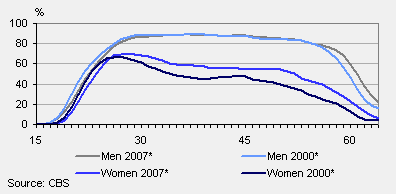Growing number of women economically independent

In the period 2000–2007, the proportion of economically independent women has grown. There was a striking increase among 30 to 55-year-old women. The number of economically independent men remained stable.
Gender gap narrowing
The proportion of economically independent women has risen from 39 to nearly 45 percent between 2000 and 2007. For men it varied around 70 percent. Hence, the gender gap has narrowed over the period 2000–2007.
Economically independent men and women

More working women
With respect to economic independence, the gap between men and women is partly due to the fact that a large proportion of women work shorter hours or stop working altogether once they become mothers. Few men, on the other hand, seem prepared to adjust their work schedule when they become fathers. As these role patterns are broken down, the difference between the genders becomes smaller. In 2006 and 2007, when the economic climate was favourable, more women managed to find work.
Considerable increase among 30 to 55-year-old women
The increase in the proportion of economically independent women was chiefly realised in the 30–55 age category.
The female labour participation rate rose from 46 to 56 percent.
Economic independence by age

Sharp increase among over-55s
Economic independence also increased substantially among 55 to 64-year-olds between 2000 and 2007. This applies to men (from 51 to 59 percent) as well as women (from 15 to 26 percent). The government discourages early retirement and as a result fewer people stopped working on a voluntary or involuntary basis prior to their 65th birthday.
The number of economically independent people under the age of 25 declined between 2000 and 2007, because young people tend to study longer.
Wim Bos and Marion van den Brakel